This story was co-published with The News & Observer, a member of the ProPublica Local Reporting Network.
One afternoon in mid-July, hundreds of people gathered around a stage in front of the historic gray stone courthouse at the heart of the small town of Graham, North Carolina. They were listening to a song of protest.
“We don’t want to die,” a local musician sang out to the diverse crowd.
The group wanted the removal of a marble statue of a Confederate soldier that had stood watch over the town square since white citizens of Alamance County erected it in 1914. But protesters in this central North Carolina county seat were seeking much more.
“We don’t want to die no more,” the man belted out again.
Across the street from the monument, dozens of people, most of them white, lined the manicured edge of a small park. They waved Confederate battle flags. Some wore T-shirts purchased at a local motorcycle shop that sells patches with Nazi symbols and KKK “life member” insignia. The shirts bore a picture of the town’s Johnny Reb statue with the words “I ain’t coming down.”
A brass bell that once tolled from the roof of the original courthouse, built before the Civil War and demolished in the 1920s, sat at the center of the park. A man in the crowd had seized control of it, heaving its clapper over and over against the bell’s lip to drown out the protesters.
The singer and his audience did their best to ignore the noise. “We don’t want to die no more,” he sang out again. The bell ringer looked around. Nobody, including nearby law enforcement officers, tried to stop him. He picked up his pace. The singer continued, “That’s why we on a riot.”
For many protesters, the statue symbolized the deep injustices that continue to plague America: the police and vigilante violence that killed George Floyd, Ahmaud Arbery and so many others; the criminal, voting and nuisance laws that appear to invariably favor white people; the backlash that seems to follow every small gain in Black political power.
Their demonstration, the first of its kind here in living memory, signaled that a vocal demand for change was rising in Alamance County, a place where the civil rights movement never flourished. Even with the surging national momentum of Black Lives Matter, the protesters knew the odds of change were steep. Black people still endured racial slurs in the town square and grocery stores. The governing boards of the city and county were all-white and had been that way, with brief exceptions, for a century and a half. Many Black people feared even going downtown.
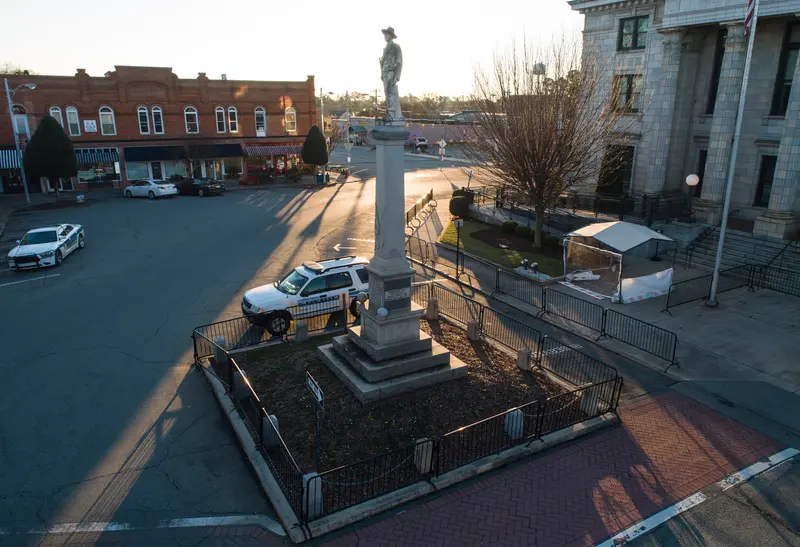
Alamance County offers a rare view into the fight for racial justice in small-town America. With its long history of violently suppressing Black political action, it is an especially bitter battlefield in the national conflict over race, police and power. Locals seeking change launched a stubborn rebellion after Floyd’s death, bound together by grief and a sense of profound unfairness. Law enforcement cracked down, sending dozens to jail. People calling themselves Confederates backed the status quo, and some grew increasingly radical.
A raucous and diverse coalition of church leaders, longtime activists and newfound converts collided with the most visible representative of the local power structure: Sheriff Terry Johnson. A tireless political operator, Johnson had served as the county’s top law enforcement official since first being elected in 2002. So dominating was his presence that supporters and opponents alike refer to Graham as “Terry’s Town.”
Johnson first banned demonstrations on courthouse grounds, but a federal judge ruled against him in early August. Switching tactics, the 71-year-old sheriff kept the heat on by outfitting his deputies in military gear and repeatedly arresting protesters for minor infractions. His actions delighted his base of voters, who like to describe Alamance as North Carolina’s last bastion of conservatism, a place where “Southern heritage” has yet to be diluted by outsiders. And he inspired the Confederates, who saw in him their truest defender.

Since Floyd’s death in Minneapolis last May, Johnson and his deputies have jailed scores of protesters. A judge and a prosecutor deemed some of the charges unconstitutional. Deputies arrested a woman at one protest for swearing after they tackled her husband. At another, they arrested a man for impeding traffic by standing on a curb with a sign held aloft. Charges against both were dropped.
Civil rights groups criticized Johnson for overly aggressive police tactics. Deputies body-slammed one man after he called them “pigs” while leaving a county commissioners meeting. Grandparents and young children were choked by clouds of pepper vapor during a preelection march to the polls.
In an interview in March, Johnson said his approach was necessary to keep order. He pulled out a copy of the oath he took when he became sheriff and read it aloud:
“I, Terry Steven Johnson, do solemnly and sincerely swear that I will support the Constitution of the United States; that I will be faithful and bear true allegiance to the State of North Carolina, and to the constitutional powers and authorities which are or may be established for the government thereof; and that I will endeavor to support, maintain and defend the Constitution of said State, not inconsistent with the Constitution of the United States, to the best of my knowledge and ability; so help me God.”
Personal politics or racism play no role in his decisions, he said: “I have no preference for anything except following the law.”
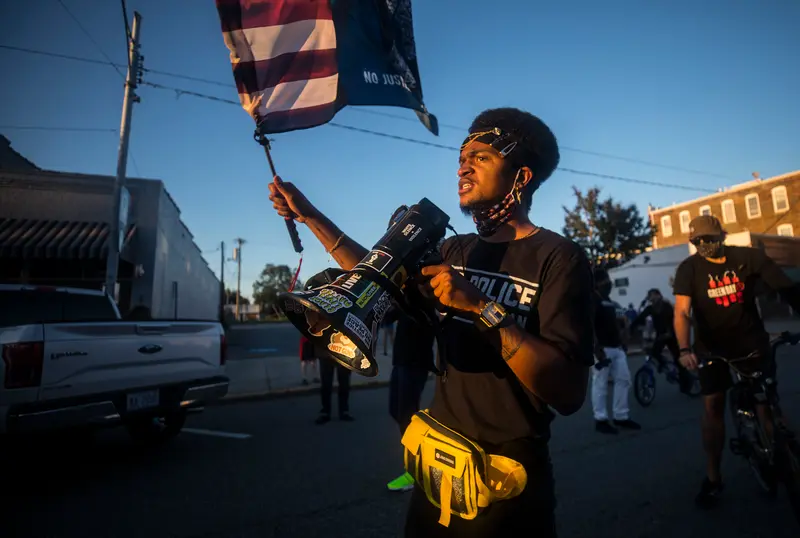
But the law hasn’t always protected Black people in Alamance County. Ku Klux Klan chapters that formed there after the Civil War were infamous for extreme violence, including the lynching of the county’s foremost Black leader in 1870. In the 1920s, the governor sent members of the state militia to Graham to stop a lynching, but the ensuing shootout left a bystander dead. A month later, a masked mob kidnapped a Black man and shot him to death.
In the 1960s, locals vigorously protested school integration. At a rally of 500 parents in 1968, a clergyman invited the ultraconservative John Birch Society and the Ku Klux Klan to join his group’s campaign against the federal government’s school desegregation plan. In 2012, the U.S. Department of Justice filed a lawsuit alleging that the Alamance County Sheriff’s Office had racially profiled Latinos. Johnson fought the charges and won in district court, settling only after federal officials filed an appeal.
In recent years, there have been signs that Alamance County is changing. In 1990, the county’s population was 79% white and 19% Black. An influx of Latinos has helped drive the population to 163,000, a 51% increase over three decades. Last year those residents helped elect Ricky Hurtado, the first Latino Democrat to serve in the state legislature. The county is now 64% white, 20% Black and 13% Latino. In Graham, white people barely make up a majority.
Once a textile hub, Graham has turned into a bedroom community for the industrial Triad cities of Greensboro, High Point and Winston-Salem and the high-tech Research Triangle to the east. People come for easy highway access and cheap rent. A new breed of businesses has followed: a yoga studio, a craft brewery, a coffee shop where new arrivals sip lattes against a backdrop of exposed brick. Colorful murals on downtown walls feature phrases like “Love, Graham” and “Love Always Wins.”
But under the Confederate soldier’s stony gaze, one thing never changed. At every challenge to white dominance, especially when outsiders joined the cause, Alamance County leaders put up a determined fight.
As the crowd strained to hear over the old bell’s toll that July afternoon, demonstrators saw strength in their numbers, their persistence and their ability to broadcast defiance. They joined the singer in the chorus: “We don’t want to die no more, that’s why we on a riot!”
A century had passed since the bell last summoned townspeople to court or church. But to many in the crowd that day, it seemed that the 400 pounds of cast metal was ringing with a sound of judgment that echoed through time.
“Ask Me About Wyatt Outlaw”
Along with the bright murals and new businesses reshaping downtown Graham came Dionne Liles, a vintage clothing trader who had been based in Durham.
Liles aspired to build a business that could serve as a community space, but was also an outsider, not even from the South. Liles, who uses they/them pronouns, was perplexed to be asked repeatedly for their opinion on the Confederate monument.
“Because of my ignorance, I was like, it’s a part of history, whatever,” said Liles, who opened The Muse in January 2020, becoming Court Square’s only Black proprietor.
The days after Floyd’s death brought a painful education.
On May 31, Liles and two employees made Black Lives Matter signs and walked into the square, where a Graham police lieutenant almost immediately threatened them with arrest. He said they needed a permit to protest. In 1967, the City Council had enacted an ordinance requiring permits for demonstrations involving two or more people, a measure intended to stifle civil rights protests.
Liles didn’t want to be responsible for their teenage employees’ arrest, so the trio retreated to the store, where they watched through the window as other would-be protesters were shooed away.
Liles later tried to get a protest permit, but that experience was just as bewildering. They felt dismissed, unsure how to navigate the rules. A conversation with a police sergeant left them in tears.
“You could just feel that it wasn’t right,” said Liles, who once dreamed of working in law enforcement. “This entire experience has been very emotional for me because I thought the system worked. I just had a lot more faith, I guess, in all of it.”
In June, when dozens of Confederate sympathizers gathered on Main Street, Graham’s history snapped into focus for Liles. No law enforcement officers shut that demonstration down, and when Liles and a friend walked by, one man called the two of them a racial slur and a few followed them down the street.
Talking with friends afterward, Liles hatched a plan. Protests might require a permit, but walking tours did not. About 200 people gathered under the “Love Always Wins” mural on June 25. As the group made their way around the perimeter of the square, some of the organizers wore T-shirts that read: “Ask me about Wyatt Outlaw.”
It was an invitation to learn about one of the darkest tales in the history of Alamance County.
Outlaw was a former slave who rose to prominence after the Civil War. He owned a shop in Graham just down Main Street from Court Square, where he did carpentry and metalwork and ran a saloon that likely served as a hub for political organizing.
A leader in the Union League, a secret society that sought to bring freedmen into politics, Outlaw co-founded a school and a church, and tried to instill in Black people the courage to vote. He had the ear of Gov. William Woods Holden and was elected to the town commission in 1869, making him Graham’s first Black elected official. Then the mayor, a fellow Republican, appointed Outlaw to an armed patrol he was forming to ward off Ku Klux Klan attacks.
In the eyes of the white establishment, if there was anything more threatening than a powerful Black man in the post-Civil War South, it was a powerful Black man with a gun. A local lawyer, Jacob A. Long, had established a chapter of the Ku Klux Klan whose 700 or so members represented about half the county’s voters. It included people from both the working class and the elite, war veterans and the sheriff and his deputies. Klan members in Alamance tortured Black people and their white Republican allies while pretending, in long white robes and horned masks, to be ghosts of Confederate dead.
The Klan came for Outlaw late one Saturday night in 1870. Pairs of robed men on horseback posted up in front of the home of anyone who might intervene, then a group of about 20 crashed through the doors of Outlaw’s home. They pulled the bedcover off his 73-year-old mother and discussed ways to kill her. The mob shouted:
“Cut her head off!”
“Blow her brains out!”
“Let us set the house afire.”
They found Outlaw in a room with his children and forced him out half-dressed. In the square, they hanged him from an elm tree and slashed his mouth with a knife. Outlaw’s body stayed there, in the rain, until nearly noon on Sunday. People feared touching him, as if whatever blame led to his death might rub off. A Black man who followed two of the killers home was soon found dead in a millpond, his foot tied to a 20-pound stone.
Pinned to Outlaw’s body was a warning: “Beware, ye guilty, black and white!” But those guilty of murdering Outlaw and terrorizing Alamance County were never brought to justice. In 1870, Holden, a Republican, declared Alamance County in insurrection for failing to protect its citizens. He sent in troops, but failed to quell the revolt. Holden was impeached and removed from office for his actions against the insurgents. Klansmen cemented their political control in the state, helping to end Reconstruction in North Carolina earlier than in other states.
Some 40 years later, Alamance citizens gathered in front of Graham’s courthouse to dedicate the rebel statue. The master of ceremonies was Long, the onetime Klan commander who was indicted but never tried for Outlaw’s murder. He said the event’s purpose was to “recall the achievements of the great and good of our own race and blood.”
The white establishment’s overwhelming victory in Alamance helped inspire the screenplay for “The Birth of a Nation,” the 1915 film that powered the resurrection of the Ku Klux Klan.
At Liles’ walking tour more than a century later, organizers passed out hand-drawn pamphlets that recounted Outlaw’s murder. On the front panel, Outlaw was depicted with a question mark over his face. No photographs exist of him. What did he look like? What was his story?
For at least one resident who learned about Outlaw for the first time last year, the most puzzling question was why the white citizens of Graham waited as long to kill him as they did.
“Why,” Avery Harvey asked, “did they wait until he won?”
“What Sets Your Soul on Fire”
As he drove into town on the day of the July civil rights protest, Harvey gaped at the hundreds of people in the streets. He had grown up in the area, but had never witnessed so many Black people in downtown Graham.
The protesters flooded North Main Street, where a stage had been set up in front of the Confederate statue. Seized by the moment, Harvey pulled into a parking space and rushed to join the crowd. He took out his phone to record the excitement and danger.
“I’m a Black activist,” he said into the camera as he walked bare-chested toward a crowd of white people displaying mocking signs and Confederate battle flags. “I’m out here, you hear me?”
Unlike Liles, Harvey was not shocked by displays of overt racism. He was raised in Gibsonville, a railroad outpost 10 miles west of Graham. When he was 12, Harvey said, he and friends crossed the tracks to the white side of town. They tried to go swimming at a private pool, but they discovered a “whites only” sign on the gate. The pool clerk said they needed a million dollars worth of insurance to enter. It started to make sense why their parents never went into restaurants, instead collecting food from a side window.
When Harvey declared himself an activist that July day, he was better known as a Blood. While affiliated with the gang, he had racked up arrests for breaking and entering, assault and resisting a police officer. He said he left the gang in 2018 and tried to start a new life in New York. But escaping his past wasn’t so easy. His mom called him home, saying she wanted to see him on his 30th birthday, and when he returned to Alamance County people still called him “Blood.”
Harvey was thrilled by the acts of Black defiance unfolding in front of him that day. He watched as protesters seized control of the bell the Confederates had used to try to drown them out.
He thought of the sentence he had inked on his forearm the day he covered up his gang tattoos with a rosary and a lion: “Be fearless in the pursuit of what sets your soul on fire.”
“This is it,” Harvey said to himself. “The revolution is here.”
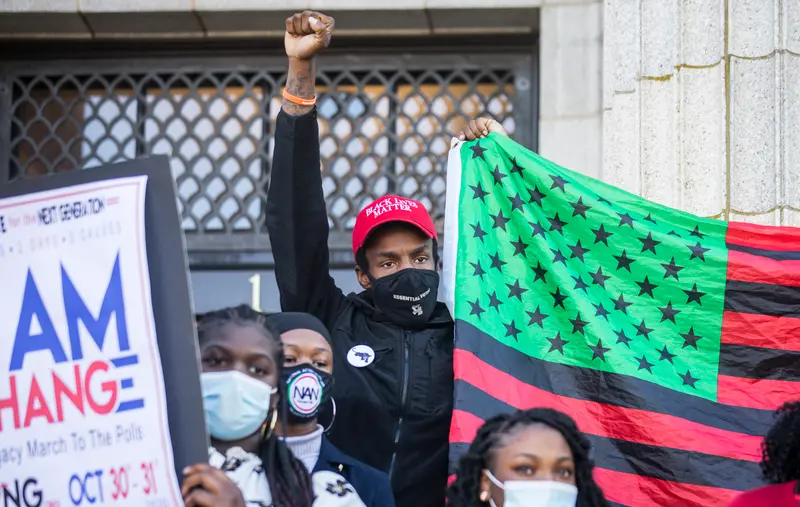
His life and possessions in New York receded in importance as the bell’s tolling drew police and counterprotesters back into the park. One officer shoved a protester named Maurice Wells off the bell’s brick pedestal. Harvey raced to Wells’ defense, though the two had never met. “That’s too much force, sir,” Harvey told the officer. “You didn’t have to push him.”
On the other side of the bell, the founder of the Confederate heritage group Alamance County Taking Back Alamance County, or ACTBAC, was yelling orders at police. “Do your job!” Gary Williamson shouted, his arms flailing and face red with anger. He clenched his jaw, baring his teeth.
Officers called for help from the sheriff, the one man who had the power to calm the situation down. Johnson had once coached Williamson in football at Southern Alamance High School. It was home of the Confederates when Johnson played there, renamed the Patriots by the time of Williamson’s school days.
“You know when I tell you something, you better listen,” Johnson told Williamson after arriving, his arm draped around his former student’s shoulder. “Take your people, and get out of here.”
The gesture of familiarity between the two men angered Wells, whose own family roots go back generations in Alamance County. He began to belt out the chorus to “Ring My Bell,” the Anita Ward disco classic. It was a way to make himself laugh and to restrain his fury.
“I’m going to ring your bell again,” he called out in the direction of Williamson and the sheriff, a declaration he repeated with an expletive-filled flourish.
Johnson ordered Wells to be put in handcuffs. After he was hauled away, a woman protested: “Why did you arrest him?”
“He refused to leave and was using language that is not decent language,” Johnson told her. Later, in court, he denied that the arrest had been about profanity, saying instead that Wells was inciting a riot.
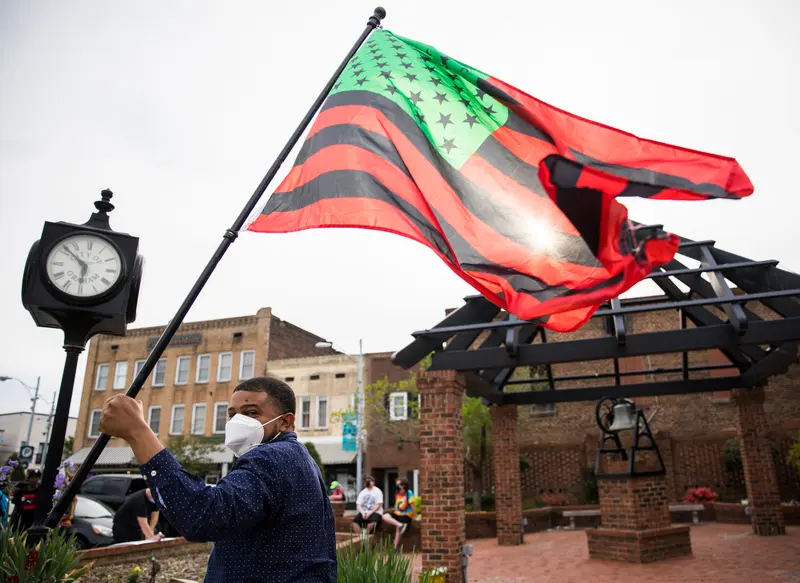
Johnson emphasized in a March interview that the arrest was not personal.
“I ain’t gonna take him to my house and go out and eat with him, but I like the boy,” he said, referring to Wells, who is 34. “He does not understand what he’s doing to himself for the future years to come by getting involved in undisciplined protest, not being peaceful.”
Images of Johnson with his arm around Williamson were widely shared on social media. The images, along with the arrests and Johnson’s silence on whether to remove the statue, seemed to confirm what many people understood about Alamance County politics. The people in power are sympathetic to the Confederates, they said. They want the statue to stay up, and support tight controls on dissent. Williamson declined comment.
For those familiar with Alamance’s recent history, that message was clear. A deadly white power rally in 2017 in Charlottesville, Virginia, prompted protesters to tear down a Confederate statue in Durham. Soon after, Alamance officials rushed to ensure that nothing similar happened there.
Amy Scott Galey, then a county commissioner and since elected to the state Senate, asked Johnson to step up patrols in downtown Graham to quell any unrest.
Galey was an especially influential figure. She was a member of one of North Carolina’s most storied political families. The Scotts had produced two governors. Gov. W. Kerr Scott, elected in 1948, also served in the U.S. Senate in the 1950s. Gov. Bob Scott, elected in 1968, recalled in an interview that his great-grandfather was among the Klansmen who had been rounded up, then released, in the wake of Outlaw’s death.
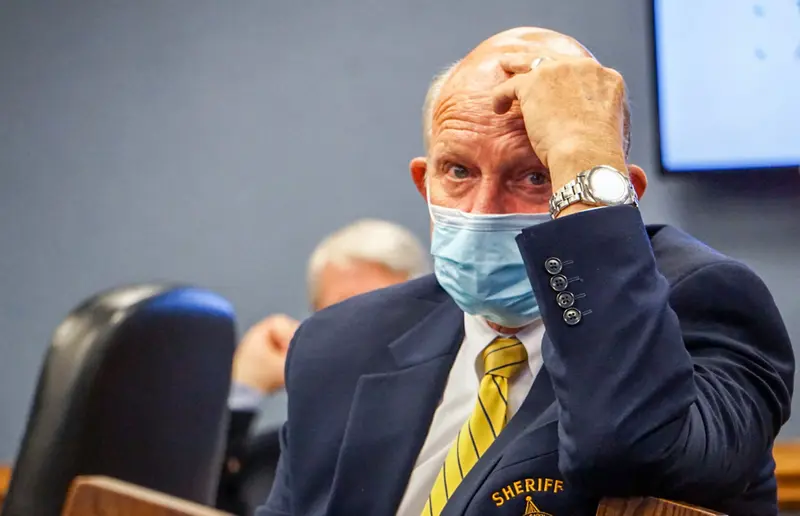
“We are a government of laws, not of men, and a few people must not be allowed to overtake the process of lawful republican government,” Galey wrote to Johnson in an email, according to a summary she posted on Facebook.
Galey and the other commissioners agreed that the statue must stay up. They pointed to a 2015 state law passed after a white supremacist killed nine people at a Black church in Charleston, South Carolina. It blocks the removal of such monuments except in extremely limited circumstances.
Commissioners also made their personal feelings public at board meetings. Bill Lashley, a former cop and a Johnson ally who died last year, suggested that people accept the monument and move on. “If it offends anybody, then you need to look the other way,” he said. “It’s part of our history. We’re not proud of our history sometimes, but it’s still history.”
Tim Sutton, another commissioner at the time, declared his pride in his Confederate heritage. “I am not ashamed of my great-grandfather,” he said. “He did what he did. It is my understanding that when he died, from Sarah, my grandmother, that some guys on the farm, you can call them slaves if you want to, but I would just call them workers, that they raised a good bit of my family. When the time came, my great-grandmother gave them land. I am not going to be a part of an assault on logic, an assault on the history of this country and the heritage of this area and this country. Not going to do it.”

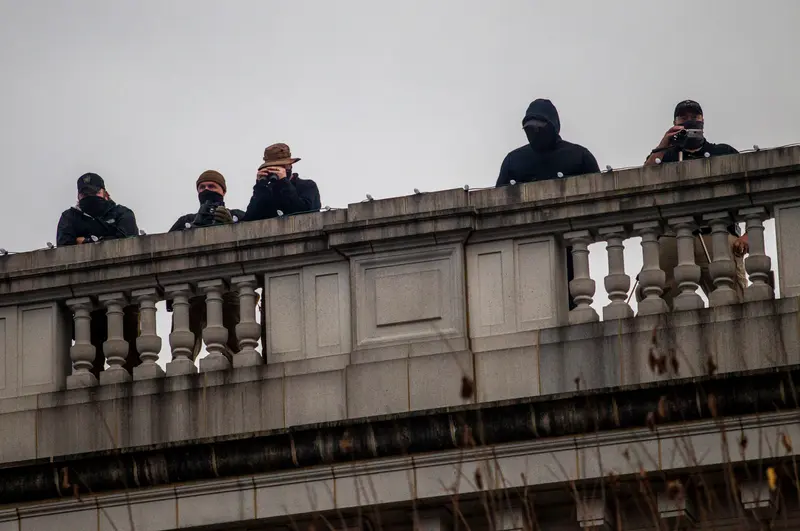
Over the years, the same arguments were voiced again and again, even as at least 20 other Confederate monuments across North Carolina came down. The 2015 law had an exception that allowed officials to take down a monument if it posed a public safety risk. Despite frequent standoffs between pro- and anti-statue groups, and pressure from business and community leaders, Alamance’s Board of Commissioners never invoked the exception.
Johnson said in an interview that triggering the monument’s removal is beyond his authority, though he had warned commissioners that there is a public safety risk. He declined to offer his own opinion on whether the monument should come down.
“Write this down,” Johnson said. “Politics stinks.”
“Charlottesville Is Coming Here”
Johnson has seen protests descend into political violence before.
He was a high school senior in 1969 when Black student protests against racism in the neighboring city of Burlington were followed by fires, looting and the police shooting of a Black teenager.
Later, while majoring in criminal justice at East Carolina University, Johnson took a third-shift job as a sheriff’s deputy and worked the chaotic night in 1972 when a police officer shot a Black man in Greenville, pitching that city into a wave of rioting.
In 1979, a few years after Johnson joined the North Carolina State Bureau of Investigation, he was assigned to a Communist-led “Death to the Klan” march in a Black neighborhood in Greensboro. A Klansman turned police informant hollered: “You asked for the Klan and you got ’em!” before Klansmen and Nazis jumped out of a convoy of cars and started shooting.
From his post at a traffic checkpoint, Johnson heard the shots that left five marchers dead. The sound, he said, still rings in his ears and guides his decisions about the protests in Graham today.
“We’ve got some controversy, you know, from people saying, well, y’all didn't allow this, you didn’t allow that,” he said. “Well, let me tell you what, it’s no fun when you hear shots ring out and people are dying.”
From the start of his career, Johnson distinguished himself for an aggressive style of law enforcement.
As a new agent in the SBI, he made headlines in his mid-20s for targeting the Rockingham County sheriff in a corruption investigation of sex trafficking at local truck stops and claiming his investigations were stymied by Democratic Party politics.
The investigation, still one of Johnson’s proudest accomplishments, coincided with a federal probe that eventually took down several public officials. Johnson said a contract on his head forced him into hiding.
After a reporter asked him about the investigation, Johnson arranged for the reporter to meet with him and one of his investigation’s targets. In the parking lot behind Johnson’s church, a man pulled up in a truck, and Johnson invited him into the back seat of his SUV. Johnson said even though his investigation had targeted the man, he wound up testifying for the prosecution.
For the man, who declined to be identified because another witness in the case had been killed, Johnson had always been about one thing: law and order. The two joked back and forth about how dogged Johnson had been in his pursuit of suspected criminals.
“I’ll tell you what makes him tick,” the man said of Johnson. “Dope dealers. Trafficking in girls.”
Johnson chimed in, “Murders, rapes, robberies.”
When Johnson ran for sheriff in 2002, he campaigned on his record numbers of arrests and convictions. Once in office, he brought his tactics to another controversial issue: immigration enforcement. Johnson turned his jail into a federal detention hub and announced that deputies would go door-to-door checking that registered voters with foreign-sounding names were actually citizens.
By 2010, the U.S. Department of Justice had opened a civil rights investigation. The department announced two years later that it had found Johnson’s deputies were as much as 10 times more likely to stop Latino drivers than non-Latino drivers on three major roadways. The investigation pointed to a discriminatory use of checkpoints, jail booking practices and deputies’ use of anti-Latino epithets.

Johnson denied the charges and fought federal prosecutors at every turn, refusing to turn over documents or make deputies available for interviews. A federal judge ultimately ruled that the Department of Justice had not proven its case, but in the same decision upbraided the sheriff for sloppy oversight and “offensive and reprehensible activity” among staff. The DOJ appealed, and in 2016 Johnson settled with the Obama administration, agreeing to undergo anti-bias training and to collect data on the ethnicity of people who deputies stop and search.
Among many locals, the story had a different cast: Johnson had beaten the DOJ. His reputation as someone who could stand up to outsiders was sealed. During the most recent election, nobody ran against him.
While sheriffs generally wield outsized power, Johnson’s status in Alamance stands out.
Megan Squire, a professor from nearby Elon University who keeps a close eye on Alamance politics, said, “He’s got this almost mythical stature.”
In October, Johnson used the prospect of unrest as a political tool. The Johnson for Sheriff Committee paid for a full-page newspaper ad blasting one Democratic county commissioner candidate for posing for a picture near a toppled statue and two others for joining political demonstrations, including a 2016 Martin Luther King Day march.
“Marches, defending voter fraud, celebrating lawlessness,” the ad’s bold type read. “Vote for law and order. Vote Republican.”
When protests over George Floyd’s killing started in North Carolina, Johnson’s playbook was ready. He had already met with city officials after the Charlottesville rally to review Graham’s protest ordinance. After Floyd died, Johnson banned protests on territory under his direct control: the grounds surrounding the town’s historic courthouse and its Confederate monument.
When a federal judge found in July and then again in August that those measures likely violated protesters’ First Amendment rights, Johnson shifted to force, his other primary tool.
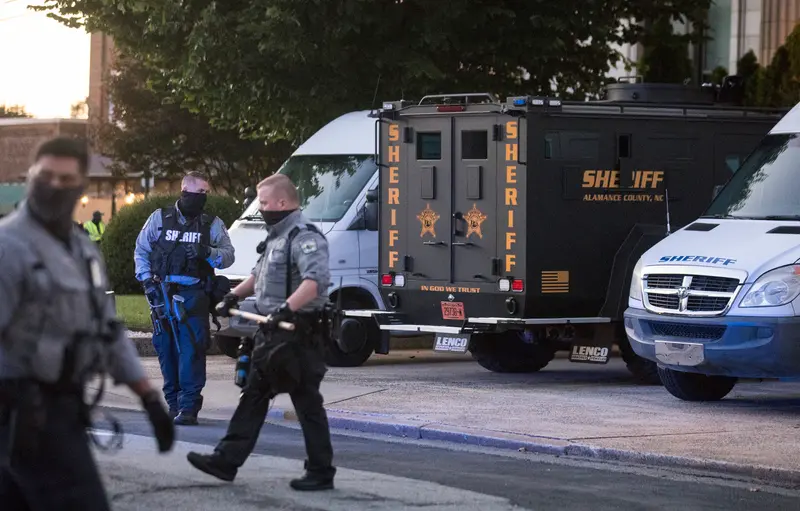
Johnson’s deputies hauled nearly three dozen people to jail over the course of more than 50 large and small protests that took place in Graham over the next year. All the arrests except for one were of Black Lives Matter supporters, even though the Confederates, or Southern patriots as some called themselves, swore and fought during protests too. That sole exception was a 36-year-old white woman arrested on a warrant for failing to appear in court on drug charges.
This pattern stood in marked contrast to local police, who joined deputies in enforcing the laws at the protests. Graham police arrested or cited Confederates 14 times. In comparison, they did so 22 times to Black Lives Matter supporters. Both protest groups included people who don’t live in Alamance. About one-fifth of the Black Lives Matter protesters arrested did not have local ties.
For Johnson, that’s at the heart of the problem.
“I wish those people, if they’re going to come just to cause trouble, would stay at home,” he said in an interview. “Let our people try to work whatever problems we have here out.”
For locals, Johnson tried to be approachable. He told Harvey he had an open-door policy and agreed to sit down with a group of demonstrators. Though no specific changes developed from their talks, Harvey felt optimistic that the sheriff might be open to deeper listening. They continued to talk. “I love you,” Harvey said at the end of their conversations. The sheriff said, “I love you, too.”
In October, with the presidential campaign heating up, Johnson would face another major test. The organizers of the July march would be taking over the town square again, this time to usher people to the polls.

Pepper Spray in Peaceful March
Harvey had been working himself to exhaustion trying to persuade people in poor, Black neighborhoods to vote. Many told him they didn’t want to stir up trouble. One woman who attended a county board meeting in July woke up later that night to a person in a white-hooded outfit banging on her garage door.
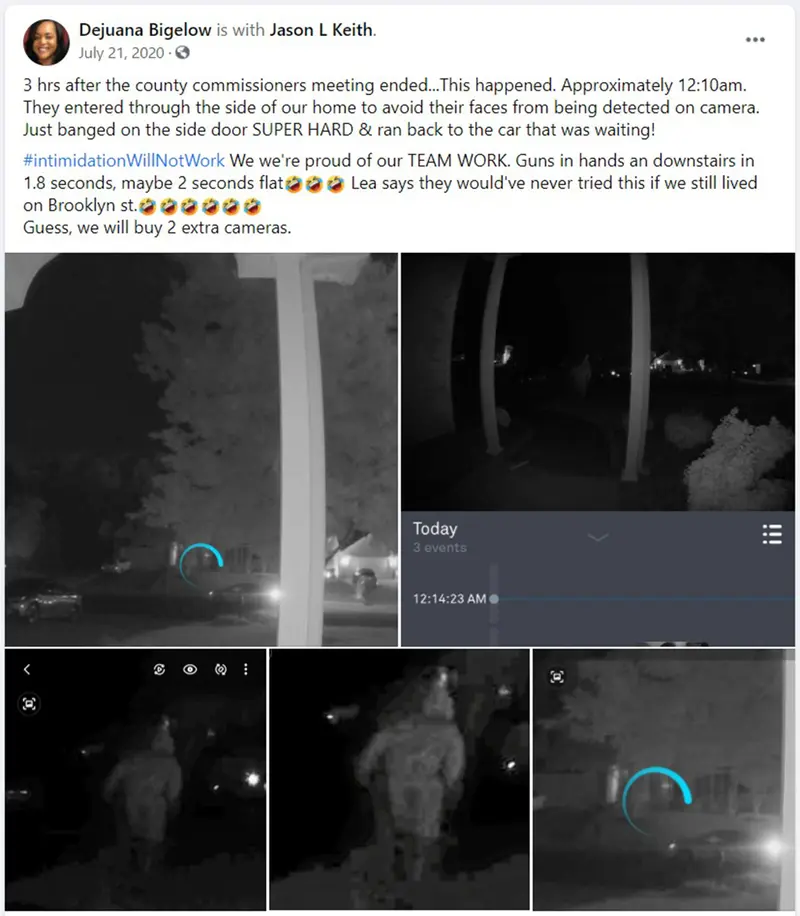
Activism had consequences.
In the push to register other people, Harvey had neglected to enroll himself. He had voted for Barack Obama, but hadn’t updated his address.
Halloween, the day of the march to the polls, was the last day of early voting in North Carolina and Harvey’s last chance to get on Alamance County’s voter rolls.
That morning, a crowd amassed outside Wayman Chapel, the church that Wyatt Outlaw helped found. They were set to march down the path Outlaw took to his death, then pivot toward the polling site on West Elm Street.
In the parking lot where the crowd milled, T-shirts advertising “Good Trouble 4 Change” and “Justice for the Next Generation” were for sale. Two men blessed people by wafting smoke toward them from burning sage bundles. One of the men wore an angel costume. He offered prayers of protection, his white balaclava topped with a tinsel halo.
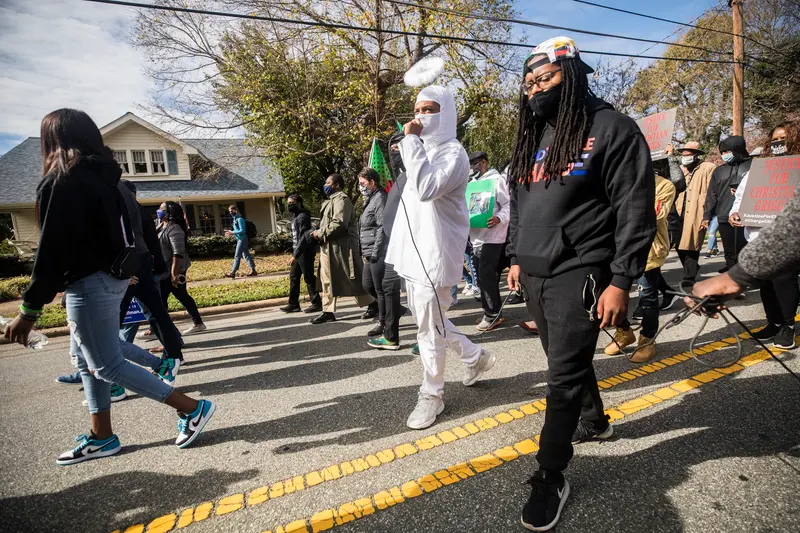
The march had been organized by the Rev. Greg Drumwright, a Black pastor based in Greensboro who had grown up attending church in Graham. Invited back by local activists, Drumwright was trying to make his name in the national movement, traveling to flash points like Minneapolis and Louisville, Kentucky, with a camera crew documenting his every move. He arrived in the parking lot as part of a convoy of four white luxury vehicles, including a Maybach.
The “I Am Change” march was billed as a family-friendly finale to a season of Black organizing. Many people brought their kids to witness what they hoped would be a show of power strong enough to reset history.
Marchers entered Court Square singing, “We ready for change.” When they reached the statue, several people lay facedown on the asphalt to recreate Floyd’s final position when he was killed in Minneapolis. Others kneeled or stood with heads bowed. After holding their positions for the more than eight minutes that Floyd had spent on the ground with a knee on his neck, the crowd rose. They expected to continue their protest in the street.
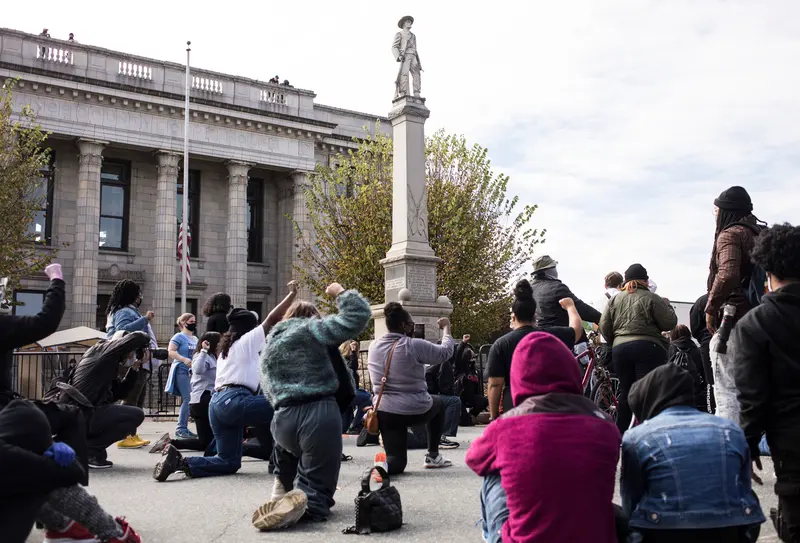
Instead, a half-dozen Graham police officers formed a line and told marchers to clear the road. The crowd reacted with an unwieldy mix of confusion, resignation and defiance. It wasn’t obvious where they were supposed to go, and not everyone heard the commands. Wells tried to get people moving. As police officers moved in, one protester shouted into a megaphone, “These streets belong to us!”
The police reacted with force. One Graham officer aimed a pepper fogger at the speaker’s feet. The irritant quickly choked Wells’ 61-year-old mother, who was holding tight to his arm. At the second spray, Harvey started coughing. Small children retched as parents whisked them from the scene.
Reacting to the pepper spray, protesters scattered. Alamance News reporter Tomas Murawski was in the street photographing. Police grabbed Murawski and arrested him. Protesters were stunned by the arrest of a working journalist and by the force officers used to twist Murawski’s arm above his head.
Police herded the remaining protesters toward a barricaded area near the courthouse entrance, where Drumwright and others proceeded to address the crowd using a speaker system. The permit issued by Johnson’s office allowed only battery-powered amplification on courthouse grounds, but organizers had brought a gas-powered generator and a gas can. Eight of Johnson’s deputies rushed toward the audio setup. One attempted to seize the generator.
In the scuffle that followed, a female deputy hit the ground. Deputies and Graham police rushed in, unleashing more pepper spray.
One protester with a disability, Janet Nesbitt, was sitting about four feet from the speakers in her motorized scooter. She felt like she couldn’t breathe. Awash in anxiety, her body began to buck. Another woman sank to the ground screaming, “I can’t see!”
Video from the scene quickly went viral. In the flood of news about the most contested presidential election in recent history, the images from Graham broke through. They seemed to typify the voter suppression and intimidation that Democratic pundits had been warning about.
Though Graham officers were the first to use force, criticism rained down most heavily on Johnson. He was the most senior law enforcement official in the unified command center, and his deputies were the heavies in camo. Johnson was quickly likened to Bull Connor, the civil rights-era Birmingham public safety commissioner whose use of vagrancy laws, fire hoses and German shepherds on protesters made him infamous.
Harvey had taken a break from the protest to get a meal of teriyaki chicken wings with Wells and his mother at a restaurant on the west side of the square. A police officer approached them while they waited for their food outside the restaurant and told them to go back to the designated protest area or face arrest. Several white protesters and journalists stood nearby but received no orders to move.
“Because I’m Black!” Wells yelled. “Is that why you’re going to arrest me?” He and Harvey said they intended to eat. Wells’ mother pushed him toward the restaurant.
“My destination is anywhere I please,” Harvey said before turning to follow them. An officer came from behind and grabbed him by the arms. Police seized his megaphone. He had intended to register to vote later in the day. He never got the chance.
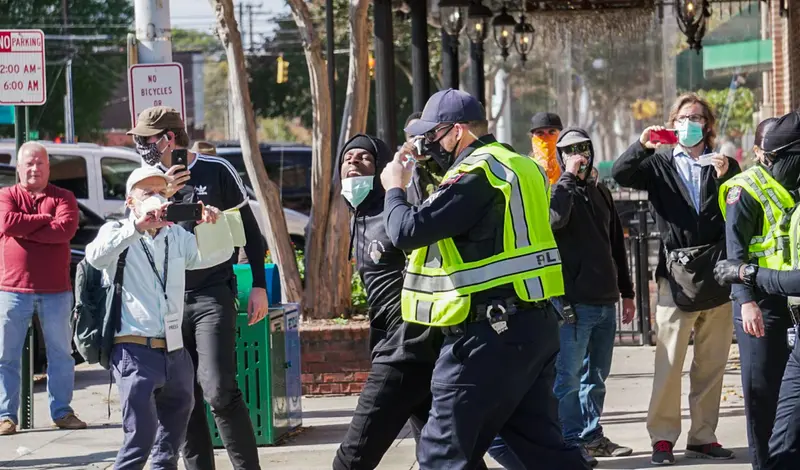
By the end of the day, Johnson’s deputies and Graham police officers had blanketed scores of protesters with pepper fog, a chemical irritant. They had arrested 20 people, including several leaders of the protest movement. Johnson insisted the response was warranted because the terms of the event permits were violated.
“When you protest and have violence or do not follow the rules, it actually counteracts any good that you could possibly have obtained by doing it the right way,” Johnson said.
After the march, Johnson painted Drumwright as a violent outside agitator. He announced felony charges of assault on an officer and obstruction of justice, which were later dropped. He mischaracterized what Drumwright said at a meeting of community organizers, suggesting the pastor had called for a riot. The district attorney’s office tried to have the pastor banished from all county property, a souped-up version of the 72-hour banishment from Graham that magistrates had tacked onto many BLM protesters’ bail conditions.
“We understand and they understand why they are spewing a false narrative,” Drumwright said at a November news conference. “I’m here to tell you that it is deplorable. Deplorable that the county would respond in this way instead of addressing what it did. It is deplorable that the county continues to violate people’s rights.”
Though protesters continued to march and demonstrate in the square, much of their attention was diverted to the cases moving through the courts.
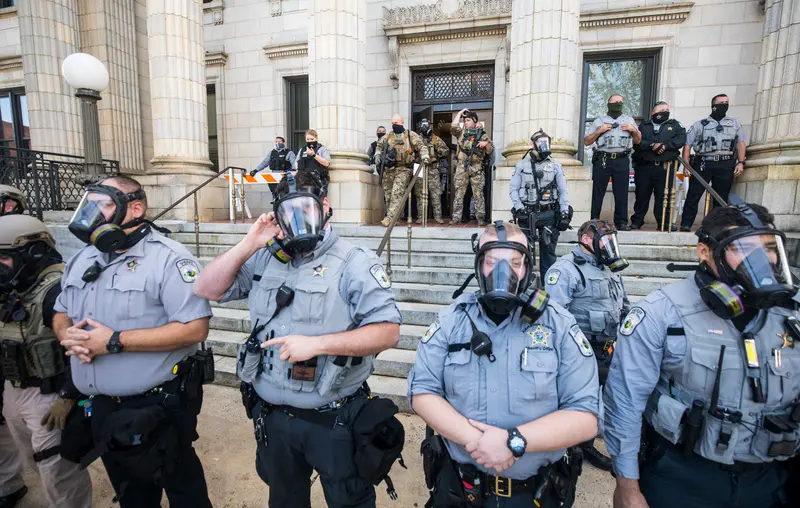
Civil rights groups filed two federal lawsuits, still pending, that allege that Graham and Alamance County violated the Ku Klux Klan Act of 1871 and other laws. The aggressive response to the march was a conspiracy by law enforcement leaders to deter voting and stifle peaceful expression, the NAACP Legal Defense Fund and the Lawyers Committee for Civil Rights Under Law argue. Graham and Alamance County denied the allegations.
Protesters began to receive summonses to appear in court to face charges. Harvey, who had been repeatedly arrested, knew judgment was coming for him again.
“It’s just like a chain reaction,” he said. “You get arrested one time, they get you on the radar. Get arrested another time, it’s like OK, I gotta keep going to court, maybe pay a fine, whatever. It’s another way to oppress us. Silence us.”
The Capitol Riot
At virtually every Black Lives Matter demonstration in Graham, Thomas May was standing nearby with a Confederate battle flag propped on his shoulder, watching, often taunting.
May’s amiable conversations with demonstrators about Bible verses morphed over the months into something more hostile. He could be heard by protesters and journalists saying the N-word. One night, he appeared to pantomime a lynching, though he said he was really just scratching his neck.
Even the polls presented an opportunity for trolling. On Oct. 18, wearing a Proud Boys shirt, he cast a ballot for the first time in his life. He was 48, motivated to vote by an admiration for President Donald Trump.
At the polling place, May found Johnson standing in line. The two chatted. May recalled later that Johnson told him they wanted the same thing: for Graham to get back to normal. The conversation with Johnson left May feeling he had done the right thing in opposing the Black Lives Matter protests.
“It’s really not about the monument, and we all know that. Alamance County is one of the last, if not the strongest, conservative county left in North Carolina,” May said. The BLM protesters “hate Sheriff Johnson,” he said. “If they got the monument down, they would be happy, yes, but I mean they want Sheriff Johnson” out of office.
He had a new T-shirt made. Above a Blue Lives Matter flag it read “I support Sheriff Terry Johnson.”
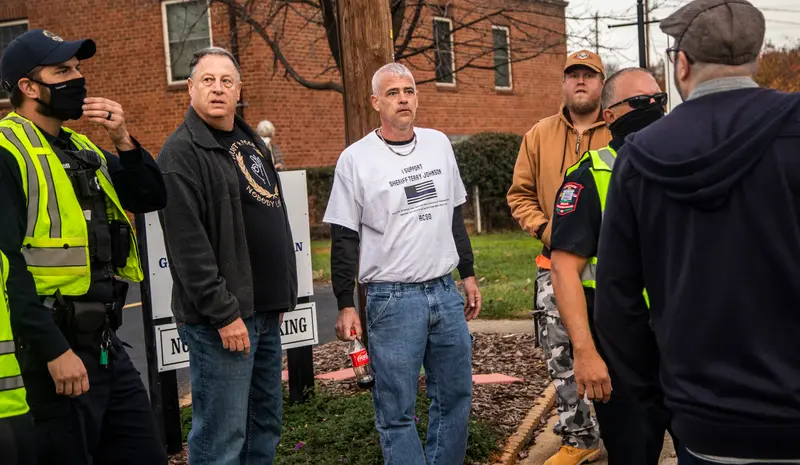
May didn’t have the same pro-law enforcement attitude earlier in life, when his drug use contributed to a string of arrests and a felony conviction for breaking and entering. A religious awakening in Alamance County jail, May said, set him on a new path.
Back in June, when May first started spending his extra time in Graham, it was mostly to get a break from workaday monotony. No partner was waiting at home at the end of his shifts as a manufacturing worker. His father, who had been both his housemate and his best friend, had died a few years before. Softball games had filled his weekends and fed his competitive streak until he injured his knee.
Politics, which he’d never much paid attention to before, started to seem much more interesting than sports. He had cut off his cable after COVID upended the NCAA tournament and began relying more heavily on Facebook for news. When Duke basketball coach Mike Krzyzewski announced his support for Black Lives Matter, May renounced the team he’d once fanatically cheered on.
The more May learned about Trump, the more he found to approve. He liked the president’s economic policies. Trump railed against the free trade agreements that Alamance County residents like May’s parents blamed for the loss of their reliable textile mill jobs. May said he and his coworkers each saw their take-home pay rise substantially after Trump’s tax cuts, and his retirement account grew.
Grief led May back to the family Bible his father had left behind. Bookmarking its pages were memorial cards listing the names of ancestors unknown to him. His research revealed that some had fought for the Confederacy. Slowly, he found himself the county’s most prominent voice for the Confederates’ cause.
May became the administrator of the main local Facebook group. Members of more long-standing Southern heritage organizations, like the secessionist League of the South, bid for his attention. Sutton, the now-former county commissioner, sent May messages affirming his support for protecting the monument. Local restaurants gave him free food.
May liked the spotlight, and for the first time since his dad died, he felt like he had a family. May and his new friends traveled around the Piedmont together, brandishing their battle flags and sometimes eating together at cookouts.
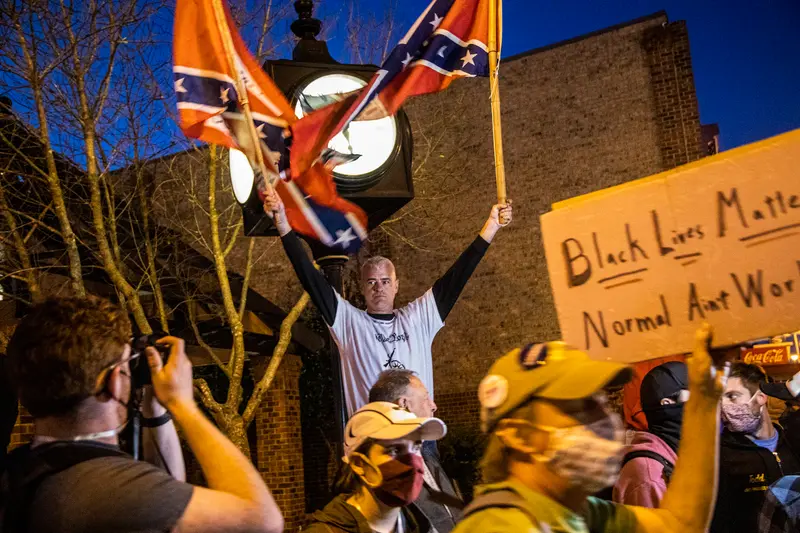
In repeated confrontations with BLM and anti-fascist demonstrators, May and his friends had grown closer, and he himself had changed. In some ways for the better, he thought, in other ways probably for the worse.
“I’ve been thinking about it,” he said recently. “BLM made me who I am.”
Trump’s support for Confederate monuments and his condemnation of BLM and antifa delighted May. During a presidential debate in September, Trump was asked whether he would condemn the Proud Boys, a right-wing group that frequently battled racial justice protesters in the streets. Instead, Trump seemed to embrace the group, telling the Proud Boys to “stand back and stand by.”
The president later condemned the group. But May took the initial seeming endorsement seriously. The Proud Boys were a supercharged version of the family of monument defenders he had come to know in Graham.
He decided to apply for membership and sent an email to an address an acquaintance had passed along.
A Proud Boy vetting applications for a local chapter of the group sent him a video clip. It showed May and a fellow Confederate named Steve Marley riding in the back of a truck during a Trump convoy in September. Somebody shouts, “White power!” as the truck drives past. May denied it was him. But it did not matter.
The Proud Boys rejected him, May said, on the grounds that white supremacists were not allowed in the group.
The rejection did not dissuade May from joining the Proud Boys at the Million MAGA March on Dec. 12 in Washington, D.C. He wore a shirt with the word “Exterminate” over a symbol associated with antifa and carried a Confederate battle flag. Video and images posted to Twitter by an anti-fascist activist show May with an Alamance County man who appears to drag a Black man to the ground and kick him in the head. May said in an interview that the Black man had a knife and had earlier been seen with a group burning either a Trump-branded hat or stuffed animal. He and others chased after the man, May said, adding, “If I had the chance to kick him, I would have kicked him.”
He later joked on Twitter about getting new steel-toed boots for his next trip to Washington on Jan. 6, saying there was a “rumor” that “Alamance County knows how to use them.”
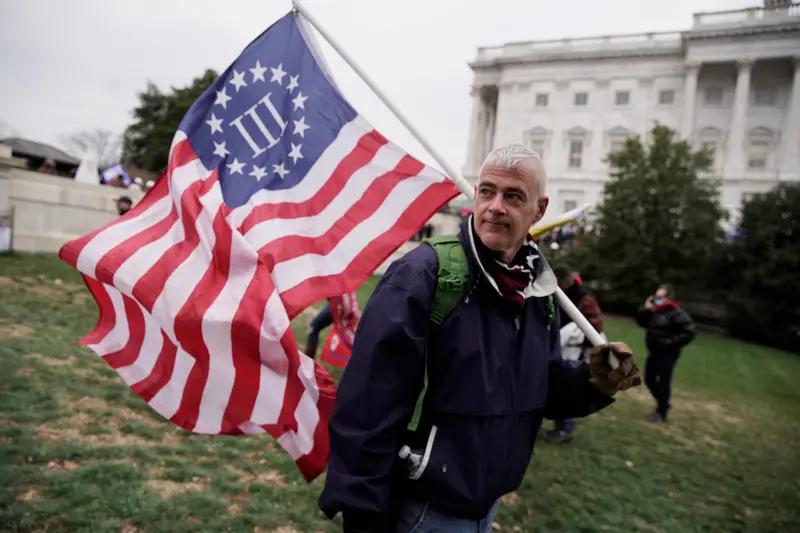
The morning of Jan. 6, May lined up at the base of a set of stairs leading to the U.S. Capitol. When the people in front of him surged forward, he joined the charge.
May called a reporter and yelled into the phone, “We’re storming the Capitol.” He later called back: “It’s like a war zone. I’ll be quiet so you can listen.”
The Arrests
Harvey was arrested in December on a disorderly conduct charge after one of May’s friends called him the N-word in Court Square. According to charging documents, Harvey swore at May and his friends and said, “What you going to do,” as if gearing up for a fight. May’s friend Robbie Butler Jr. was arrested for disorderly conduct for using the racial slur. Harvey is awaiting trial. Butler pleaded guilty but received no criminal penalty.
At the jail that day, Harvey said, sheriff’s deputies locked him in a cell with two hulking members of the Aryan Brotherhood who had swastika tattoos on their chests. There was no need to fight to defend himself this time. Harvey said a little smooth talk kept things civil, and the men put their shirts back on. What stuck with him was the laughter of the deputies who looked on, he said.
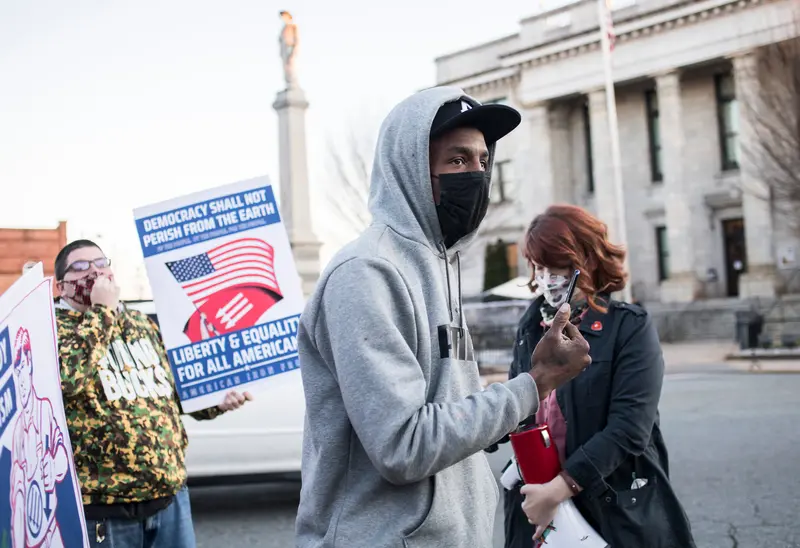
In February, Harvey was arrested again. His cousin, who he says is like a brother to him, was driving him through Graham when blue lights flashed behind the pair. The streets were dark and empty. Considering how police treated him in the public square, Harvey worried about what they might do with no witnesses.
Harvey could make out the face of the officer trying to pull them over. His horror deepened.
He saw Brandon Land, a Graham police officer who Harvey concluded had made him a special target.
In September, Land had told a friend of Harvey’s that he intended to arrest Harvey for even the smallest infraction. “You tell your friend Avery that if he comes out here and so much as steps off the curb, or says a cuss word, I’m locking his ass up,” local photographer Lee Vaughn recalled Land telling him after a protest in Court Square.
Another activist brought Harvey home from that September demonstration, and, minutes later, Land showed up at his apartment complex. Harvey figured he had been followed. In his experience, police hardly ever came to this neighborhood, where nearly everyone was Black. His neighbors were drunk and fighting with each other, and Harvey tried to broker peace. He intervened in a fight involving his cousin. Land soon told him to put his hands behind his back. He was being arrested for assault.
A magistrate inappropriately applied a 48-hour jail hold that would ultimately lead to the case being dismissed. Harvey said Land pointed out on the drive to jail that the hold, which normally applies to domestic violence charges, would keep him from protesting over a holiday weekend. Graham police said in an emailed statement that the magistrate applied the hold, not the officer.
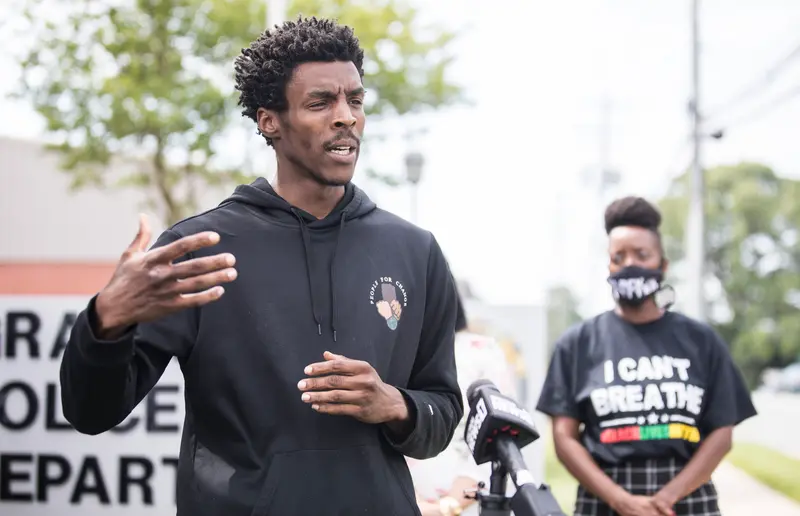
Five months later, Land was back and Harvey’s cousin had just taken off running. As Harvey leaped out of the pulled-over car, he saw that Land was accompanied by another officer he feared, Marcus Pollock, who had shot and killed a Black man, Jaquyn Light, the year before.
He hoped the officers’ familiarity with him could keep the worst from happening. “It’s Avery,” he yelled. “Please don’t kill my cousin.”
“It’s Christmas in February,” Harvey said Land told him repeatedly with a smug smile. Police found cocaine in the vehicle, according to an arrest report. Land charged Harvey and his cousin with felony cocaine possession. No publicly available documents identified the amount, and police and the district attorney declined to say.
Land and Pollock did not respond to repeated requests for comment. The department has fought The News & Observer and ProPublica in court to prevent the release of related body camera footage.
After he was let out of jail later that night, Harvey returned home. But something in him was unsettled, uncertain. He walked back to the police station and stood outside, gazing at the building in the still of the night. He was trying to discern what he felt.
“Do I want to shoot them, apologize to them or say thank you for not killing me?” he wondered. He never could settle on an answer.
The Trials
It had been a discouraging few months for Harvey. He tried to hold a fast-food job, but it didn’t work out. Confederates ambushed him on the street where he lived, he said, leading to a fistfight. Someone bent the pipes to his hot water heater, ransacked his car and poured sugar into the gas tank. Some days, he struggled to find the motivation to leave the house.
Court proceedings chewed through his days. He had to attend hearings for his eight arrests, and also waited outside the criminal courthouse most Wednesdays to show support for the activists on trial inside.
One local prosecutor had been assigned to handle the bulk of the protesters’ cases. As he went through the paperwork, Kevin Harrison was reluctant to even bring some of them to trial. He dismissed one case against a woman charged with saying an obscenity to “deputies and the public in general” with a note: “Charged conduct is not a crime.”
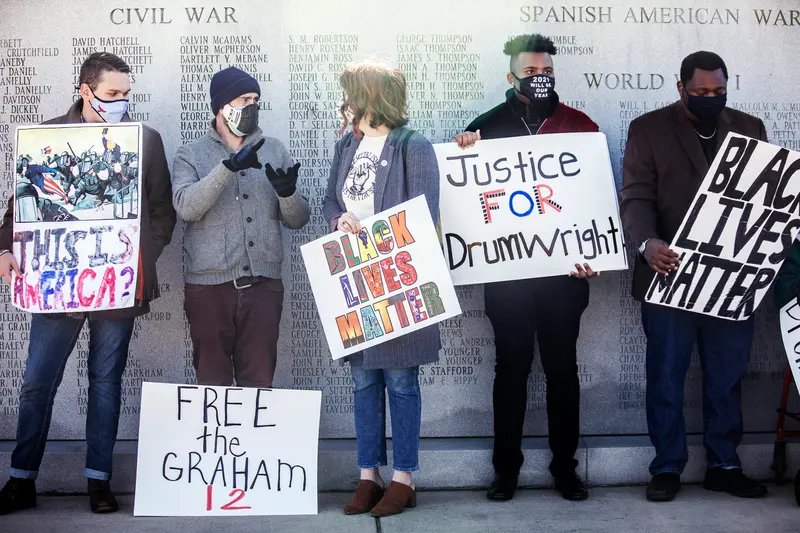
Harrison dismissed at least one other charge for that reason and four additional charges for lack of evidence, and still a judge chided him for proceeding with a case that seemed to him plainly crosswise with the U.S. Constitution.
Judge Lunsford Long declared one man not guilty of resisting an officer and failing to disperse on demand, on the grounds that the arresting officers were enforcing Johnson’s unconstitutional protest ban.
“I have a problem with this case, Mr. Harrison,” Long said. “I’m surprised you’re proceeding with it. People have a First Amendment right to express their views.”
The man was relieved by the verdict, but the charges had already cost him his job.
As of May 16, 46 charges against 30 BLM protesters had been resolved with only 15 findings of guilt. Many other charges were dismissed before or during trial, and several remain outstanding. A grand jury declined to indict Drumwright on a felony charge of assault on an officer.
Among the charges that the district attorney has chosen not to withdraw is one count of resisting, delaying or obstructing an officer levied against Tomas Murawski, the Alamance News reporter, making him one of an exceedingly small number of American journalists to be criminally prosecuted for an arrest in the course of doing his job.
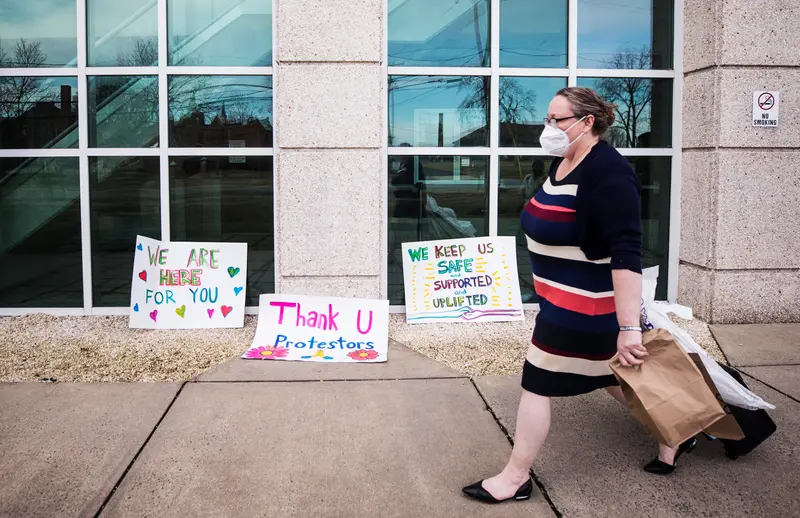
Until The News & Observer, the Alamance News and Triad City Beat filed a petition with the North Carolina Court of Appeals, local judges wouldn’t allow journalists to attend any protest-related hearings.
The trials promise to stretch beyond the one-year anniversary of Floyd’s death, with appeals extending even longer. Many protesters are involved in civil litigation that could also drag on for years.
The North Carolina NAACP, along with several local advocacy groups, members of the clergy and a former candidate for county commissioner, sued to have a judge declare that the Confederate monument should come down. Its presence violates the equal protection guarantee in the state constitution and has led to inappropriate public spending, they say. The sheriff’s protest-related spending in 2020 came to roughly $750,000. Graham police estimate their costs at $112,000.
Nonetheless, Johnson and the local establishment have been unyielding in their refusals to address protesters’ demands.
In March, Graham passed a new protest ordinance that limits megaphone volume at unpermitted events to 60 decibels, a little louder than a clothes dryer. With a few exceptions, it requires advance notification of any protest. And it makes it a crime to violate any of the terms of a permit or related rule.
Johnson has announced some modest reforms. On April 1, he unveiled the formation of a new advisory board to smooth relations between his office and the community. The board contains several Johnson allies and none of the protesters who have been active in the streets. After a Minnesota police officer allegedly mistook her gun for a taser and killed an unarmed Black man that month, Johnson ordered yellow tasers and put bright tape on old equipment.
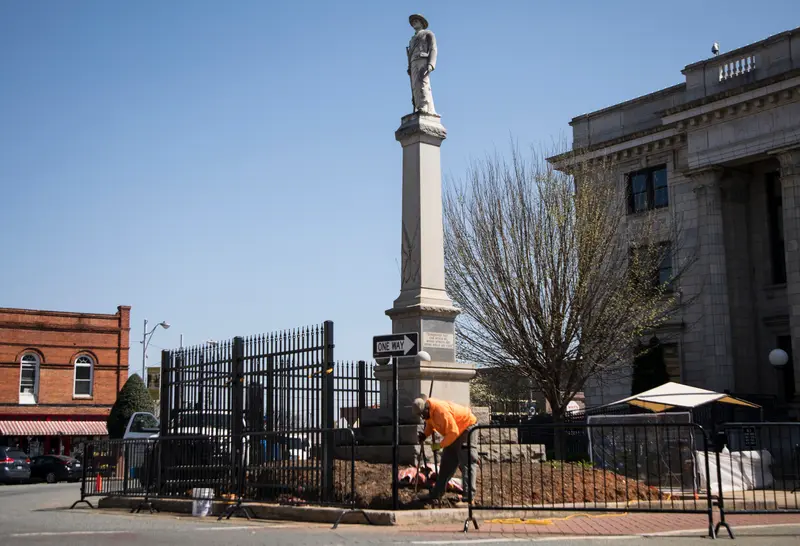
Harvey and others gathered in Graham to protest the April 21 police killing of Andrew Brown Jr., an unarmed Black man, in Elizabeth City, 200 miles to the east. Police arrested Harvey for failing to provide the advance notice required under the new protest ordinance. The following week, deputies hauled him to jail on an accusation that he defaced public property by attaching a Black Lives Matter flag to the new fence.
Meanwhile, May continued his activities in support of the Confederate cause. Federal investigators never visited after his trip to the Capitol, May said. He insists he never went inside. In a guest bedroom of his house, he built what he calls a “war room” for broadcasting on social media. He hung an American flag over a window and set up some tables around a camp chair. He pondered a new color scheme for his walls: gray like a Confederate soldier’s uniform in some rooms, red to match the battle flag in others.
These days, he spends much of his time planning a celebration of the 160th anniversary of North Carolina’s secession on May 20 on the grounds of Graham’s historic courthouse, in the shadow of the statue. May anticipates the event will draw Confederate enthusiasts from far beyond Graham.
Provided he has his freedom, Harvey will be there.
The bell in the park no longer has a clapper — the city removed that in July — so Harvey has been shopping for a mallet that won’t be mistaken for a weapon.
“We’re going to occupy that space, and we’re going to ring the hell out of it,” he said. “Other people might be scared. But I’m going to ring that bell.”
Harvey said it will send a message: “Wyatt Outlaw is still here and living.”
Alex Mierjeski contributed reporting.










